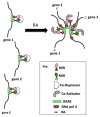Retinoids regulate stem cell differentiation
- PMID: 20836077
- PMCID: PMC3315372
- DOI: 10.1002/jcp.22417
Retinoids regulate stem cell differentiation
Abstract
Retinoids are ubiquitous signaling molecules that influence nearly every cell type, exert profound effects on development, and complement cancer chemotherapeutic regimens. All-trans retinoic acid (RA) and other active retinoids are generated from vitamin A (retinol), but key aspects of the signaling pathways required to produce active retinoids remain unclear. Retinoids generated by one cell type can affect nearby cells, so retinoids also function in intercellular communication. RA induces differentiation primarily by binding to RARs, transcription factors that associate with RXRs and bind RAREs in the nucleus. Binding of RA: (1) initiates changes in interactions of RAR/RXRs with co-repressor and co-activator proteins, activating transcription of primary target genes; (2) alters interactions with proteins that induce epigenetic changes; (3) induces transcription of genes encoding transcription factors and signaling proteins that further modify gene expression (e.g., FOX03A, Hoxa1, Sox9, TRAIL, UBE2D3); and (4) results in alterations in estrogen receptor α signaling. Proteins that bind at or near RAREs include Sin3a, N-CoR1, PRAME, Trim24, NRIP1, Ajuba, Zfp423, and MN1/TEL. Interactions among retinoids, RARs/RXRs, and these proteins explain in part the powerful effects of retinoids on stem cell differentiation. Studies of this retinol signaling cascade enhance our ability to understand and regulate stem cell differentiation for therapeutic and scientific purposes. In cancer chemotherapeutic regimens retinoids can promote tumor cell differentiation and/or induce proteins that sensitize tumors to drug combinations. Mechanistic studies of retinoid signaling continue to suggest novel drug targets and will improve therapeutic strategies for cancer and other diseases, such as immune-mediated inflammatory diseases.
© 2010 Wiley-Liss, Inc.
Figures





References
-
- Afonja O, Raaka BM, Huang A, Das S, Zhao X, Helmer E, Juste D, Samuels HH. RAR agonists stimulate SOX9 gene expression in breast cancer cell lines: evidence for a role in retinoid-mediated growth inhibition. Oncogene. 2002;21(51):7850–7860. - PubMed
-
- Altucci L, Rossin A, Raffelsberger W, Reitmair A, Chomienne C, Gronemeyer H. Retinoic acid-induced apoptosis in leukemia cells is mediated by paracrine action of tumor-selective death ligand TRAIL. Nat Med. 2001;7(6):680–686. - PubMed
Publication types
MeSH terms
Substances
Grants and funding
LinkOut - more resources
Full Text Sources
Other Literature Sources
Medical
Research Materials

